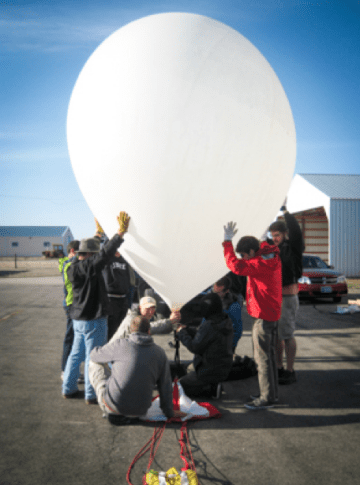Football fans can watch high-altitude balloon launch Sept. 20 from Bobcat Stadium
Students and fans who will gather in Bobcat Stadium for the Sept. 20 football game between Montana State University and Eastern Washington will experience MSU’s first game-day high-altitude balloon launch from inside the stadium.
The launch, taking place 20 minutes before kickoff, will lift a custom-made “Go CATS” banner high above the Gallatin Valley while special high-definition cameras capture spectacular images from “near-space.”

One of those images will be displayed during halftime on the Bobcat Stadium’s Jumbotron. Throughout the game, students and fans will be able to view the other images and track the balloon’s journey at http://lookup.montana.edu.
The latex weather balloon is expected to reach 85,000 feet and then float east. The entire trip could take anywhere from two to four hours, said Angela Des Jardins, director of NASA’s Montana Space Grant Consortium. Besides sharing images from the edge of space, the flight will demonstrate the benefits of a valve and computer system designed and developed by MSU students. The students can command the valve to release helium from the balloon, allowing it to stay aloft as long as the students want.
Once the MSU students see that the balloon is floating over an easily accessible location between Livingston and central Montana, they will command a tethered dart to pop it, Des Jardins said. They will then drive to its landing spot to retrieve the balloon and the scientific instruments it is carrying.
Participants in a Montana Space Grant Consortium contest will seek and retrieve the 16-by 84-inch “Go CATS” banner that will drop off earlier in the flight to avoid tangling with the descending balloon. Contest information will be updated continually at @MTSpaceGrant on Twitter.
Balloon flights are the highlight of the BOREALIS program at MSU, Des Jardins said. As a component of the NASA Montana Space Grant Consortium, BOREALIS works to strengthen aerospace research and education in Montana.
BOREALIS provides students the unique opportunity to work, fully hands on, to design, build, test, fly and analyze personalized and collaborative high altitude experiments, Des Jardins said. Students fly equipment designed to record and analyze their scientific inquiries in carefully constructed payloads that travel up to altitudes of 100,000 feet.
Students take great pride in the educational opportunities provided through BOREALIS, Des Jardins said.
Nichole Murray of Bozeman, a senior in mechanical engineering, said, “It is a very unique learning environment. It opens the door that says it’s OK to fail. It’s the idea of being able to learn from your failures and become better…. To expand and make yourself a better student…To push yourself farther than you thought you could.
“I hope that students and fans have the chance to experience the same fascination, excitement and wonder that I do with each launch that I participate in, since there is always something to learn, to observe or to question,” Murray added.